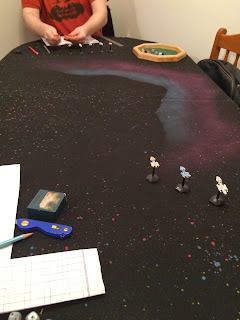NAC intel got wind of this - and despite some rather dubious characters attempting to delay any NAC response - dispatched the RNS Blore Heath to meet with other rapid response G-5 Sector ships and secure the cloaking UGC vessel.
We played this game twice, the first time being an unmitigated disaster for the NAC. Fielding a Light Cruiser, Strike Cruiser and Destroyer I was wiped out. The only saving grace had been a boarding of the stealth vessel that left is scuttled before any useful data had been recovered from it by the UGC and the destruction of one UGC frigate. C's main ship was a UGC deep space standby vessel. Complete with Advanced shields and drives, I couldn't touch it - while it's own firepower annihilated my ships one volley at a time.The advanced drives meant the advantage I had in maneuverability was lost as well.
Post game discussion we decided that it might be worth looking at the CPV rather than the NPV points system for Full Thrust. Basically NPV is the standard points buy system, but it favours large ships as due to the way the points system works they are more points efficient per weapon and hull point. Under NPV one 400 point ship is far more effective than two 200 point or four 100 point ships.
CPV works by assigning points to the combat systems of the ship, making larger hulls costlier and smaller ships more efficient. It has the downside of making smaller ships more effective - possibly leading to a situation where it's better to have 10 destroyers than 1 Super-dreadnought. However, we felt that given the smaller scale games we are playing it makes more sense to use CPV. The other side effect is it means it makes much more sense to escort larger vessels with smaller ones, rather than just using large ships on their own.
The other issue with the first game was the tech used on C's ship. To be fair, we had not talked about when in the FT timeline we were setting our scenarios, and C is not as familiar with the FT timeline than I am. This meant he wasn't aware that the Advanced Drives listed in the Full Thrust Continuum rules are actually a Kra'Vak system and not used by Human ships in the fluff. Having decided on a time period (just prior to the Xenos War) we agreed that he could use the advanced shields as they fitted the UGC doctrine - and the fact that the corporations major investments would be well protected by the best (prototype) tech.
C had also painted up some of his ships. These are from the Brigade 'British' range.
So, having gone over bits and bobs from the game, we set up again and re-ran. One of the other changes being an escalation of the NAC response, meaning I had 650 points vs the UGC 500 points. The NAC response this time consisted of the Light Cruiser RNS Blore Heath, the Escort Carrier RNS Cambuslang and two Destroyer's as escorts. Tune in to part 2 for the battle!
As for our first game, here are some pictures showing the layout - random flight stands dotted about represented sensor contacts that could not be identified until a ship was in sensor range. These varied from mines to metallic asteroids and other such things.













Hi,
ReplyDeleteJust stumbled onto this Battle Report. I'm a long time fan of Full Thrust and our gaming group is getting back into it.
Can i ask where you got that plastic/acrylic turn and fire arc template from? That's fantastic!
Al.
Hi Al,
DeleteIf memory serves it came from Figures in Comfort in the UK. I picked it up at their trade stall at a show a year or two ago.
Great, thanks. I'm contacting them now. I hope they ship to Australia.
Delete